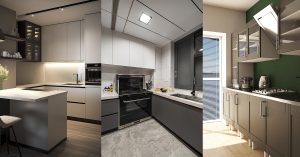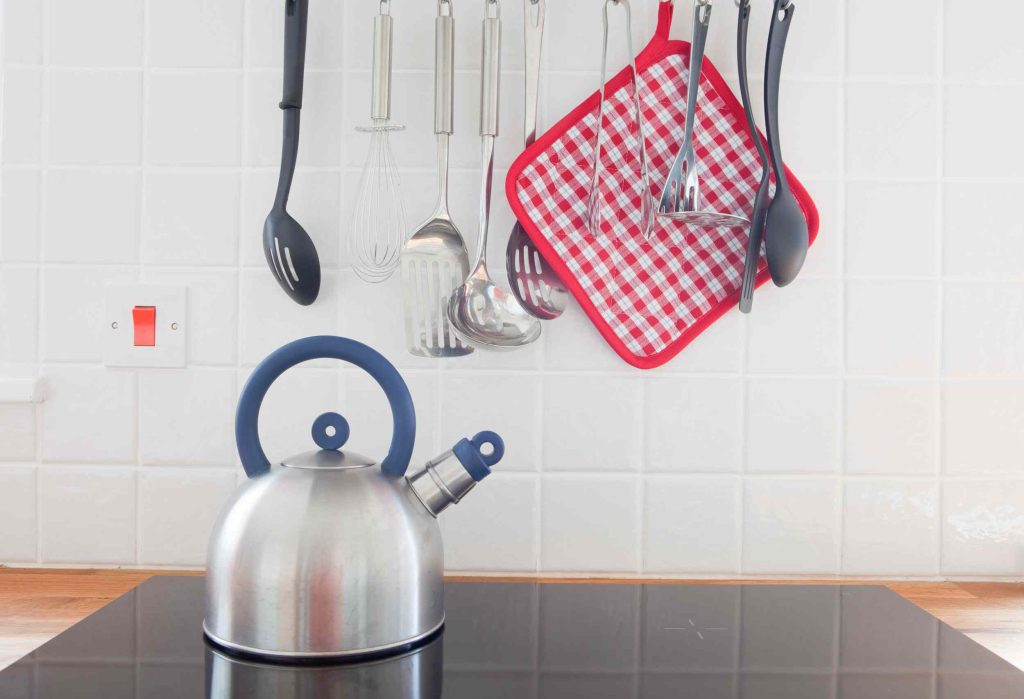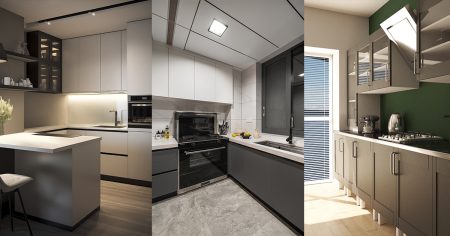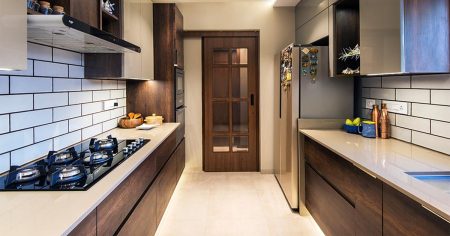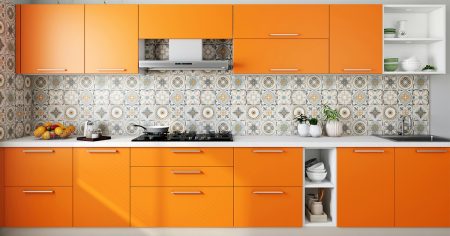Should you buy an induction cooktop or a gas cooktop in your kitchen? While the cooktops do use different fuel sources, they share several features including quick heat startup and easy temperature regulation.
Induction cooktops cost more than gas cooktops, but many homeowners find them attractive due to their energy efficiency. Though gas cooktops emit more indoor pollutants than induction cooktops, they afford the cook more flexibility with cookware choices. Induction cooktops require special cookware. Learn about induction versus gas cooktops in this comprehensive guide.
Induction vs. Gas: How They Work
An induction cooktop is a type of smooth-topped electric stove that transforms the pan itself into a heating coil. A gas cooktop heats the pan directly with a flame.
- Induction cooktop: An induction cooktop draws household electricity to create a magnetic field in the cooktop’s coil area. Protected by a ceramic glass top, the electromagnetic current in this coil reacts with metallic cookware placed on top of it. The pan heats up, not the cooking surface. There is no flame or hot coil.
- Gas cooktop: A gas range uses municipally supplied natural gas or propane as a fuel source. Gas is fed through municipal buried pipes or from an outdoor propane tank into the house. The gas supplies the stove. Lit by a spark or piezoelectric lighter, the gas ignites. The flame directly contacts the cookware to heat up the food.
Cookware Type
Induction ranges require ferromagnetic-friendly cookware such as cast iron or steel, while gas cooktops can use any type of cookware.
- Induction cooktop: Induction cooktops can use only cookware made from cast iron, enameled cast iron, or some types of stainless steel. If the stainless steel is an alloy or if it has too much nickel content, it may not work on the induction cooktop. To use non-compatible cookware on an induction stove, add a pan adapter between the pan and the stove. The metal adapter heats up and transfers the heat to the cookware.
- Gas cooktop: Gas cooktops can use any type of cookware: all pans compatible with induction cooktops, plus glass, copper, aluminum, and aluminum and stainless steel, and other blends of metal.
-
Cast iron
-
Enameled cast iron
-
Some stainless steel
-
Induction pan adaptor
-
Aluminum
-
Glass
-
Copper
-
Aluminum/stainless steel
Cleaning and Maintenance
On the whole, induction cooktops are easier to keep clean than gas cooktops due to the smooth glass top.
- Induction cooktop: Induction cooktops’ ceramic glass tops protect the inner workings of the cooktop from spills and messes. To clean an induction stove, use a sponge and a solution of vinegar and baking soda. For stubborn stains, use a ceramic glass cooktop cleaning product, which is mildly abrasive but will not scratch the glass.
- Gas cooktop: Gas cooktops’ grates, drip pans, and numerous ridges and grooves make them more difficult to clean, especially after major spills and messes. To clean stove grates, remove and soak them in a solution of warm, soapy water before scrubbing them with a nylon brush. The top needs to be cleaned by hand with a sponge.
Durability
Induction cooktops and gas cooktops, if well-maintained, are equally hardy kitchen appliances that can last as long as 15 to 18 years.
- Induction cooktop: Electric cooktops, including induction cooktops, last around 13 to 15 years. A cracked glass top or a scorching, burning smell are two of the top reasons to call in a service technician.
- Gas cooktop: Gas cooktops tend to last from 10 to 18 years. It’s important to keep the grates and burner caps clean, as these contribute to the cooktop’s wear and tear.
Cost
Gas cooktops cost less than induction cooktops by about $500 to $600 for starter models, but prices tend to equal out with higher-end models.
- Induction cooktop: Induction cooktops run between $900 and $1,900.
- Gas cooktop: Gas cooktops cost from $290 for budget four- or five-burner models, though they can go up to $2,250 for higher-end models with extra features like downdraft ventilation.
Pros and Cons
Induction Cooktops
-
Fast start-up time
-
Cool cooking surface
-
Energy efficient
-
No indoor pollutants
-
Use certain pans only
-
Surface can scratch
-
Expensive
-
Buzzes or hums
One criticism of conventional electric coil or ceramic top cooktops is that they heat up slowly. Though they are electric, induction cooktops heat up faster than conventional electric models. They even heat up as fast or even faster than natural gas cooktops. They’re also up to three times more energy efficient than gas cooktops.
Cast iron, enameled cast iron, and some types of stainless steel are the only cookware materials that can be used with induction cooktops. The glass cooktop surface can scratch, especially with uncoated metal pans. At higher temperatures, induction cooktops will emit a low buzz or hum.
Gas Cooktops
-
Change temperature quickly
-
Heats fast
-
Maintain steady heat
-
Works with all cookware
-
Energy inefficient
-
Open flame hazard
-
Indoor pollutants
-
Cleaning is difficult
Gas cooktops have long been a favorite of both home and professional chefs owning to their quick start time, steady heat, and quick responses to changes in temperature.
Yet gas cooktops do emit harmful indoor pollutants: childhood asthma has been linked to indoor gas cooktop usage. Some communities have begun to enact bans on natural gas appliances.
Efficiency
Induction cooktops are about three times more energy-efficient than gas cooktops. From an efficiency standpoint, induction cooktops are a clear winner over gas cooktops.
- Induction cooktop: Induction cooktops are 85-percent energy-efficient. This means that the vast majority of electricity generated for cooking results in cooking the food. Only 15-percent of the generated electricity is wasted.
- Gas cooktop: Gas cooktops are about 32-percent energy-efficient. Most of the potential gas energy is wasted—close to 70-percent.
How to Pick the Right Cooktop
Induction cooktops are far more common than before, with a price point that has made them attractive to a greater range of buyers. If you’d like to limit indoor pollutants and keep your house green and energy efficient, you may want an induction cooktop—as long as you don’t mind using certain types of cookware.
Gas cooktops are uncomplicated and are simple to operate for most users. If you already have natural gas installed in your kitchen, a gas cooktop may be a good choice. If your cookware doesn’t work on induction cooktops, this may sway your decision toward a gas cooktop, as well.
-
Is induction better than gas?
Induction cooktops are better than gas cooktops in terms of energy efficiency, indoor pollution, and heating start times. However, if you have cookware that is not compatible with induction cooktops you may want to stick with a gas cooktop.
-
Is it worth switching from gas to induction?
It may be worth switching from a gas to an induction cooktop if you would like to limit indoor pollutants but would like a cooktop that is comparable to a gas cooktop in many other ways, such as quick start and easy heat regulation.
-
Which is cheaper to run, gas or induction?
Depending on the prevailing cost of electricity in your area, it may be cheaper to run an induction cooktop than a gas cooktop. Induction cooktops waste only 15-percent of generated energy; in other words, 85-percent of the power goes to cooking the food. Up to 70-percent of the energy in gas cooktops is wasted.
Even so, natural gas tends to be cheaper than electricity. In terms of operational costs, this could offset the great amount of wasted energy with natural gas cooktops.
Read the full article here


